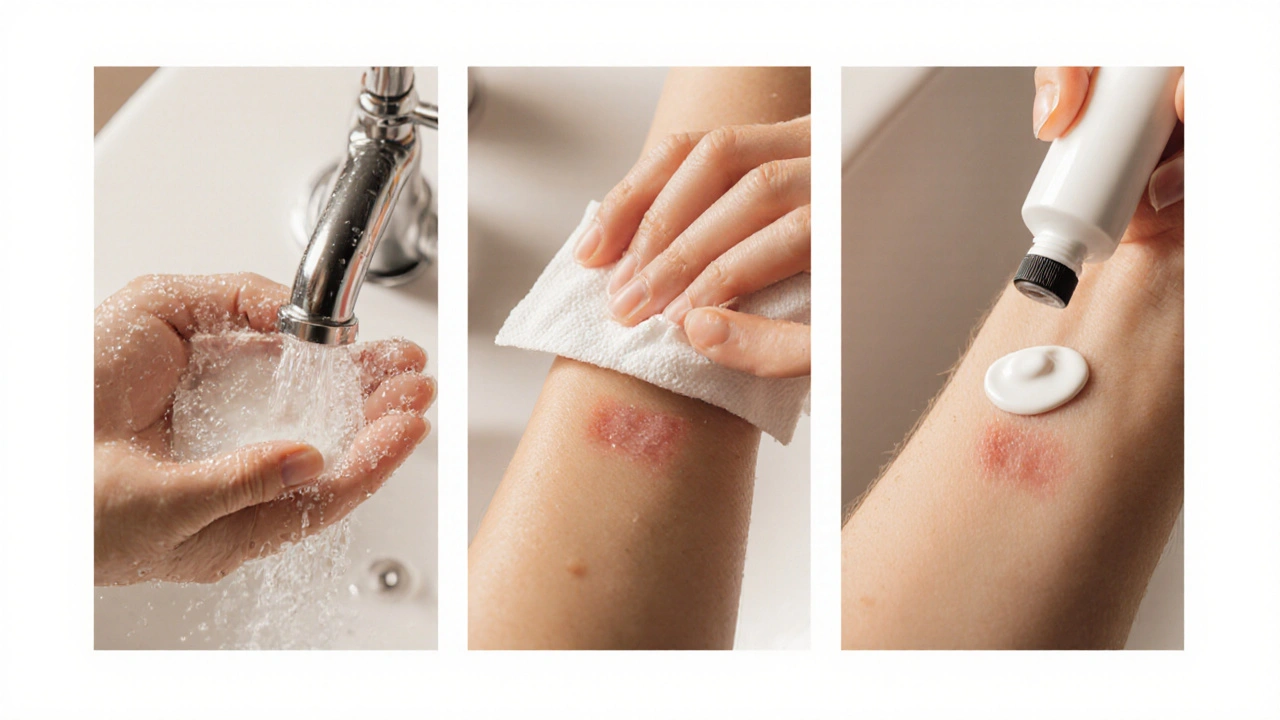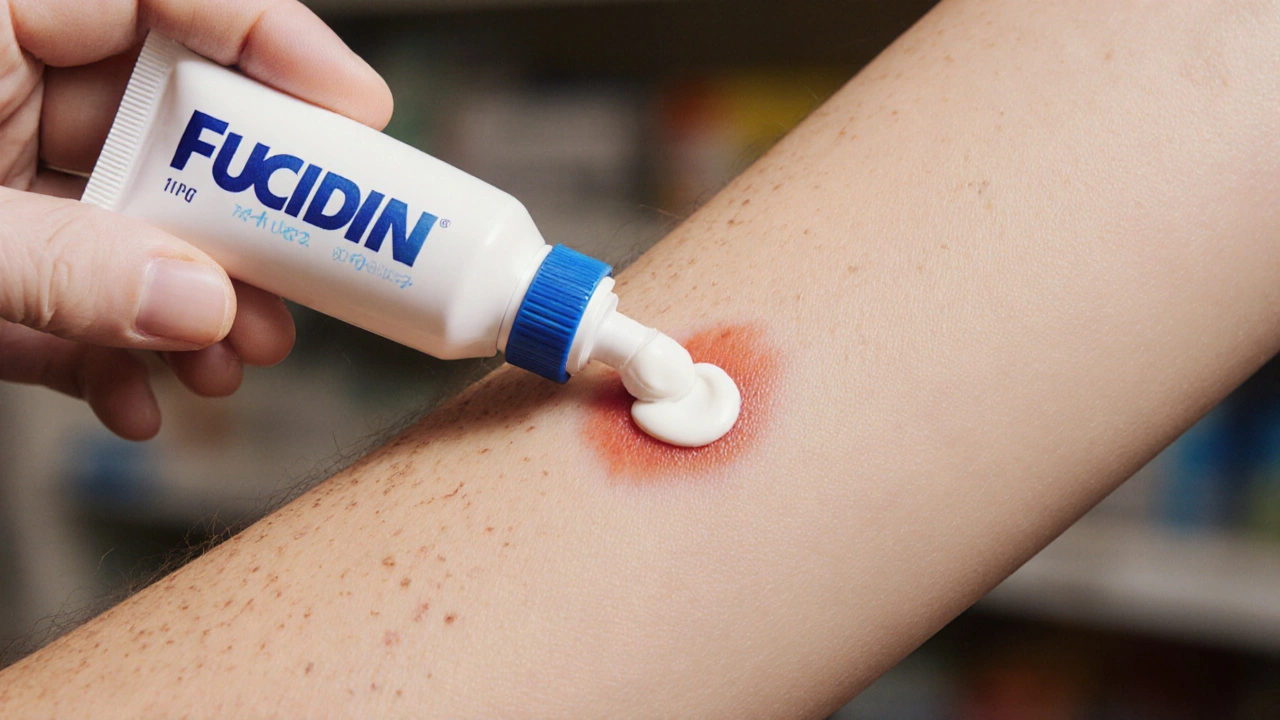Topical Antibiotic Selection Guide
Recommended Treatment
Fucidin Cream
Ideal for mild-to-moderate Gram-positive skin infections like impetigo and minor cuts.
Antibiotic Comparison Table
| Antibiotic | Spectrum | MRSA Coverage | Prescription | Cost (2025) |
|---|---|---|---|---|
| Fucidin Cream | Gram-positive (S. aureus) | Low | Prescription | £7-£9 |
| Mupirocin | Gram-positive (including MRSA) | High | Prescription | £12-£15 |
| Bacitracin | Gram-positive (Staph, Strep) | Low | OTC | £2-£3 |
| Clindamycin | Anaerobes, Gram-positive | Moderate | Prescription | £10-£13 |
| Retapamulin | Gram-positive + limited Gram-negative | High | Prescription | £14-£16 |
| Neomycin-Bacitracin-Polymyxin B | Broad (Gram-positive & negative) | Low | OTC | £3-£4 |
Key Takeaways
- Fucidin Cream (fusidic acid) targets Gram‑positive bacteria, especially Staphylococcus aureus, and is ideal for mild‑to‑moderate skin infections.
- Common alternatives - mupirocin, bacitracin, clindamycin, retapamulin, and neomycin - differ in spectrum, resistance risk, and cost.
- For MRSA‑suspected cases, mupirocin or retapamulin usually outperform Fucidin.
- Prescription rules vary: Fucidin and mupirocin need a prescription in the UK, while bacitracin and neomycin are often sold OTC.
- Correct application (thin layer, 2‑3 times daily, full course) reduces resistance and speeds healing.
What is Fucidin Cream?
When you see the name Fucidin Cream is a topical antibiotic formulation that contains the active ingredient fusidic acid. It was first introduced in the 1960s and quickly became a go‑to for skin infections caused by Gram‑positive bacteria.
Fusidic acid works by binding to bacterial elongation factor G (EF‑G), halting protein synthesis and stopping bacterial growth. Because it targets a step not commonly affected by other antibiotics, resistance develops slower than with some alternatives.
Typical Uses and Effectiveness
Fucidin is most effective for:
- Impetigo (especially non‑bullous form)
- Superficial cellulitis
- Secondary infection of eczema or insect bites
- Small abrasions, cuts, or burns that have become infected
Clinical trials in the UK show cure rates around 90% when applied twice daily for 5‑7days. The drug is well‑tolerated; the most common side effect is mild local irritation.
Alternatives on the Market
Below is a quick snapshot of the main competitors you’ll encounter in UK pharmacies.
- Mupirocin - a bacterial protein synthesis inhibitor effective against a broad range of Gram‑positive organisms, including MRSA.
- Bacitracin - a polypeptide that disrupts cell‑wall synthesis, mainly used for minor cuts and abrasions.
- Clindamycin - a lincosamide with strong activity against anaerobes and some resistant Staphylococcus strains.
- Retapamulin - a newer pleuromutilin antibiotic that covers both Gram‑positive and some Gram‑negative skin pathogens.
- Neomycin - an aminoglycoside commonly combined with bacitracin and polymyxin B in over‑the‑counter ointments.
Side‑by‑Side Comparison
| Attribute | Fucidin Cream (Fusidic Acid) | Mupirocin | Bacitracin | Clindamycin | Retapamulin | Neomycin‑Bacitracin‑Polymyxin B Mix |
|---|---|---|---|---|---|---|
| Active ingredient (strength) | 2% fusidic acid | 2% mupirocin | 500U/g bacitracin | 1% clindamycin | 0.25% retapamulin | Neomycin 0.5%, bacitracin 500U/g, polymyxin B 10U/g |
| Primary spectrum | Gram‑positive (Staphylococcus spp.) | Gram‑positive including MRSA | Gram‑positive (Staph, Strep) | Anaerobes, Gram‑positive | Gram‑positive + limited Gram‑negative | Broad (Gram‑positive &‑negative) |
| Typical dosage | Thin layer 2‑3×day, 5‑7days | Thin layer 3×day, 5‑10days | Thin layer 3‑4×day, up to 5days | Thin layer 2‑3×day, 7‑10days | Thin layer 2×day, 5days | Thin layer 3‑4×day, 5‑7days |
| Common side effects | Local irritation, itching | Burning, itching | Allergic dermatitis | GI upset (rare topical), rash | Redness, mild pain | Allergic reaction, especially to neomycin |
| Resistance concerns | Low but rising with misuse | Low; preferred for MRSA | High in chronic use | Moderate; clindamycin‑inducing C. difficile rare topically | Very low; new class | High cross‑resistance to aminoglycosides |
| Prescription status (UK) | Prescription‑only | Prescription‑only | OTC (small packs) | Prescription‑only | Prescription‑only | OTC (combined ointment) |
| Average cost (2025, per 30g tube) | £7‑£9 | £12‑£15 | £2‑£3 | £10‑£13 | £14‑£16 | £3‑£4 |
How to Choose the Right Cream for Your Situation
Pick a product based on three practical factors:
- Infection type and likely bacteria. If you suspect a simple Staphylococcus infection (common in minor cuts), Fucidin or bacitracin works. For suspected MRSA, jump to mupirocin or retapamulin.
- Prescription access. OTC users often gravitate to bacitracin or neomycin mixes, but remember they don’t cover resistant strains.
- Cost and treatment length. Longer courses increase expense; an OTC option may be cheaper but could need a repeat prescription if it fails.
When in doubt, a quick visit to your GP or pharmacist can confirm the likely pathogen and steer you toward the most effective option.

Proper Application - Getting the Most Out of Topical Antibiotics
All creams share a similar technique. Follow these steps to avoid treatment failure:
- Wash hands thoroughly with warm water and mild soap.
- Clean the wound gently with saline; pat dry.
- Apply a thin, even layer of the cream, covering the entire lesion and a 5mm margin of healthy skin.
- Allow the area to air‑dry for 5‑10minutes before dressing or covering.
- Repeat at the prescribed frequency; never skip doses even if the rash looks better.
- Finish the full course (usually 5‑10days) to prevent resistant bacteria from surviving.
Don't use plaster or bandage that traps moisture unless specifically advised - excess humidity can encourage bacterial growth.
Common Pitfalls and How to Avoid Them
- Using the wrong strength. A 2% fusidic acid cream is standard; lower concentrations (often found in compounding pharmacies) may be ineffective.
- Self‑diagnosing severe infections. Deep cellulitis, abscesses, or systemic symptoms (fever, chills) require oral antibiotics or medical review.
- Allergic reactions. If you develop a rash that spreads beyond the treated area, stop the product and seek advice - neomycin and bacitracin are common allergens.
- Mixing multiple topicals. Applying two antibiotic creams at once can increase irritation and mask signs of failure.
Frequently Asked Questions
Can I use Fucidin Cream for a fungal infection?
No. Fusidic acid targets bacteria only. For fungal conditions like athlete’s foot, you need an antifungal such as clotrimazole or terbinafine.
Is Fucidin effective against MRSA?
Fusidic acid has limited activity against MRSA. If MRSA is a concern, mupirocin or retapamulin are better choices.
Do I need a prescription for Fucidin in the UK?
Yes. Fucidin is classified as prescription‑only medicine. A pharmacist can provide a short‑term supply with a doctor’s note, but you cannot buy it over the counter.
How long should I keep using the cream after the skin looks healed?
Continue until the full prescribed duration ends (usually 5‑7days). Stopping early can let a few bacteria survive and cause a relapse.
Can I apply Fucidin on open wounds?
Apply only after the wound is cleaned and a thin film of the cream is spread over the surface. If the wound is deep, seek professional care.
Bottom Line
Fucidin Cream remains a solid choice for uncomplicated Gram‑positive skin infections, especially when you need a targeted, low‑resistance option. However, for resistant strains, broader coverage, or OTC convenience, alternatives like mupirocin, retapamulin, or bacitracin‑based mixes may be more appropriate. Always follow the dosing schedule, finish the full course, and consult a healthcare professional if the infection doesn’t improve within a few days.






Hey folks, just wanted to point out that the price difference between Fucidin and the OTC options can be a real deciding factor for many people, especially if they’re watching their budget. The £7‑£9 tag for a 30g tube of Fucidin isn’t cheap, but it’s still cheaper than a full course of mupirocin which can hit £12‑£15. If you’ve got a minor cut that’s not super infected, the bacitracin at £2‑£3 might do the trick and save a few bucks. On the other hand, for a stubborn impetigo case, spending a bit more on Fucidin could mean a quicker recovery and less chance of it flaring up again. Just something to weigh when you’re deciding which cream to ask your GP about.
October 7Abhishek A Mishra